- What is syntactic structure?
- A 'word-chain' device?
- Colorless green ideas sleep furiously -- grammatical but with a wholly improbably if not impossible string of words
- Conditional sentences
- Either/If the girl eats candy or/then the boy eats a hotdog -- the or/then must refer back to the beginning of the sentence. (And it's not simply combining the two phrases.)
- If either the girl eats candy or the boy eats a hotdog then the dog will be hungry.
- Languages "without" word order?
- Boris udaril Ivan-a
- Udaril Boris Ivan-a
- Boris Ivan-a udaril
- Ivan-a udaril Boris
- Automatic Transition Networks?
- Allows recursive loops
- Still doesn't explain 'either/if' clauses
- Doesn't explain a. discontinuous morphemes or b. raising
- Mary ran her long-lost friend from Lewisburg down (where ran and down represent a single semantic concept).
- What did Mary come to the party in ___? (Where what is the object of in and forms a semantic unit with it).
- What did you bring that book, that i don't want to be read to from out of about "Down Under" up for?
- Recursive Heirarchical Phrase Structures
- The only explanation of syntax is interlocking, recursive clauses comprising heirarchical phrase structures.
- However, all such phrases in all human languges seem to have the same heirarchical structure, regardless of whether they are noun phrases (NPs), verb phrases (VPs), adjective phrases (APs), or adposition (preposition or postposition) phrases (PPs).
- All phrases in all languages seem to consist of a head and optional specifiers, complements, and adjuncts.
- How do we prove syntax?
- Look at what people say.
- Look at what people can comprehend.
- Ask a speaker to judge a sentence for it's "correctness."
- A 'word-chain' device?
- Syntactic Categories
The basic syntactic categories are head, specifier, complement (with an e not an i), and adjunct. They form a set of relationships which may be represented in at syntactic 'tree':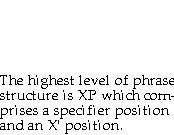
The sub-Xs on SpecX and CompX means that the categories of specifiers and complements will differ depending on the category of the XP they occur in. Only nouns allow determiners (a, the, that, etc.) as specifiers and adjectives do not allow noun complements.
- Heads
Heads are the most important category of an XP and must belong to the same category, i.e. every NP must have an N head, every VP must have a V head, etc. In the NP the big red boat, boat is the head, while in the AP most extraordinarily awesome, awesome is the head. Heads (Xs) and phrases (XPs) may be used interchangeably in phrase structures.
- Complements
Complements have the closest relation with the head and usually must occur adjacent to it and do not allow any category to occur between it and the head. For example, in the sentence They decided on the boat in the kitchen, on the boat is the complement and in the kitchen is an adjunct. This is proved by the fact that They decided in the kitchen on the boat sounds bad (ungrammatical).
The Order of Complements and Adjuncts a student of physics with long hair *a student with long hair of physics Fleetwood met Buffy over tea *Fleetwood met over tea Buffy the letter yellow from neglect *the yellow letter from neglect - Specifiers
Specifiers are usually closed-class items which specify the head or head + complement complex. Noun specifiers include articles, demonstrative pronouns, quantifiers like much, some. Verbal specifiers are usually auxiliaries or predicate particles. Adjectival specifers are intensifiers like very, almost, right.
- Adjuncts
Adjuncts are head modifiers which may be added infinitely. For example, there is no limit on the number of adjectives which may be added to a noun: the big long red gruesome . . . limosine. The same is true of adverbs: Tweeky ran quickly, surreptitiously, . . . and unsuspectingly into Lance's arms.
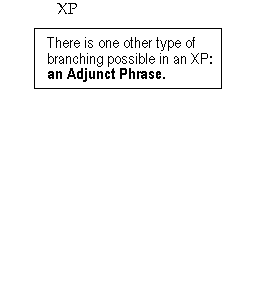
The adjunct phrase is an X' node which contains an X' node. This allows for infinite recursivity, which distinguishes adjuncts from specifiers and complements.
- Heads
- Universal Phrase Structure with Different
Categories
- The universal phrase structure of XP is realized differently depending upon whether the head is an N, V, A or P, and depending on the restrictions of a given language. The following table lists all the possibilities of NPs, VPs and APs, showing how they relate to XP in English.
XP Structure Realized as NPs, VPs, APs 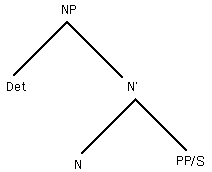
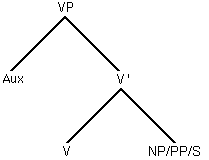
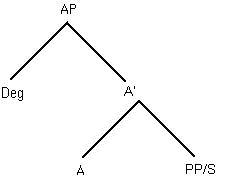
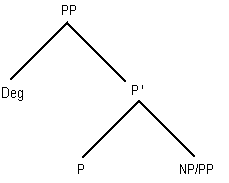
- Conclusion
All phrases comprise a head with optional specifiers, complements, and recursive adjuncts. Phrases differ in the categories which determine these phrases: nouns, verbs, adjectives and, possibly, adpositions.
- The universal phrase structure of XP is realized differently depending upon whether the head is an N, V, A or P, and depending on the restrictions of a given language. The following table lists all the possibilities of NPs, VPs and APs, showing how they relate to XP in English.